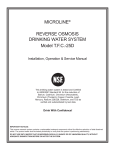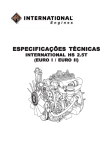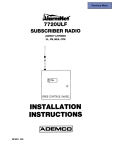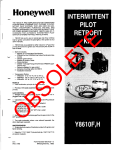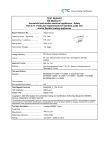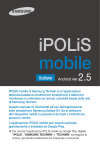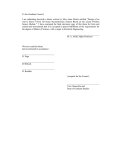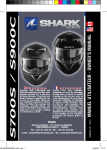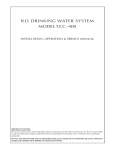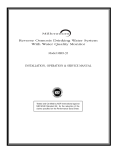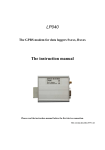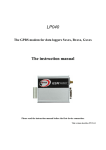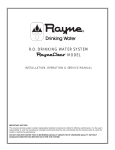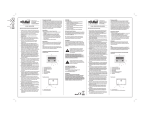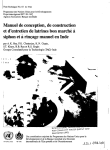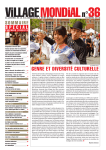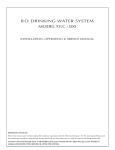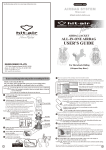Download model number marlo ro-25t reverse osmosis drinking water system
Transcript
MODEL NUMBER MARLO RO-25T REVERSE OSMOSIS DRINKING WATER SYSTEM InstalIation, Operating and Service Manual TABLE OF CONTENTS SECTION I. INTRODUCTION 3 SECTION II. SPECIFICATIONS 4 SECTION lil. PREPARATION 5 A. Major System Components 5 B. Tools Recommended for Installation 5 C. Site Selection for Major System Components 5 INSTALLATION STEPS 6 A. Faucet Installation 6 B. Feed Water Saddle Valve Installation 7 C. Drain Clamp Installation 7 D. R.O. Manifold Assembly Installation 8 E. Position the Drinking Water Holding Tank and Make the Final Hose Connections 9 F. Start Up 9 OPERATION AND MAINTENANCE 10 A. Normal Operation 10 B. Changing Filters 10 TECHNICAL DATA 11 A. WaterQuality 11 B. WaterQuantity 11 C. Water Pressure and Temperature 12 TROUBLE SHOOTING GUIDE 14 SECTION IV. SECTION V. SECTION Vl. SECTION Vll. EXPLODED VIEW AND PARTS LIST 16 SECTION I. INTRODUCTION rated from the incoming water (Feed Water) to pro duce the product water (the Permeate). The excess minerals are rinsed to drain (the Reject Water). Your new Reverse Osmosis (R.O.) Drinking Water System uses a combination of filtration technologies to reduce unwanted contaminants in a water supply. The following steps combine to give you the best in The membrane is specially constructed, fully aro' clear sparkling drinking water: matic polyamide film and is classified as a Thin Film Composite (T.F.C.). MECHANICAL FlLTRATION/ACTIVATED CARBON The sediment prefilter will remove the larger parThe spiral wound construction of the R.O. Mem ticles such as silt, rust and scale. Its 5 micron brane provides maximum surface area for water (equal to 0.0002 inch) nominal rating helps to production and is less susceptible to fouling by par give maximum life to the R.O. Membrane. ticulate matter, turbity and colloidal materials. Activated carbon particles contain a vast network of pores. The tremendous surface area of these ACTIVATED CARBON POST FlLTER-The prod pores (typically 800-1200 square meters per uct water from the Holding Tank passes through gram of carbon) gives the carbon very good the Activated Carbon Post Filter Cartridge on the adsorptive sites for chlorine as well as other subway to the Dispensing Faucet. The Activated stances that contribute to taste and odors. Carbon Post Filter Cartridge reduces tastes and odors that may pass through the system. It adds a final "polish" to the water. REVERSE OSMOSIS MEMBRANE - The R.O. Membrane is the heart of the filtration system. It is designed to reduce the dissolved mineral content of the water. Minerals picked up in the environment by the water are measured as Total Dissolved Solids (T.D.S.). In the Reverse Osmosis process, dissolved minerals are sepa- AUTOMATIC SHUTOFF VALVE - The A.S.O. Valve senses when the product water tank is full and closes the feed water supply to prevent excess reject water from going to drain when the unit is not producing water. SECTION II. SPECIFICATIONS TABLE A – QUALIFIED SYSTEM PERFORMANCE Because the performance of an R.O. Membrance is highly dependent upon pressure, temperature, T.D.S., the following should be used for comparison purposes only. MODEL NUMBER Membrane Production Rating(1) T.D.S. Reduction System Rating Warm Production Climate(2) T.D.S. Reduction Cold Climate Production (3) T.D.S. Reduction Drain (reject water ) flow Percent Recovery Product Storage Capacity (at 5 psi tank precharge and 40 psi water pressure in tank) Empty product storage tank precharge Replacement Sediment/Carbon Prefilter Cartridge Replacement Reverse Osmosis Membrane Replacement Activated Carbon Post Filter Cartridge 1. 2. 3. MARLO RO-25T 25 +/- gpd (76 – 114 lpd) 95% min 16 +/- 4 gpd (45 – 76 lpd) 90% + typical 9 +/- 2 gpd (26 - 42 lpd) 90% + typical 3 – 4 x production flow 20 – 25% RO – 102 = 2.8 gal. or RO Mate 4 = 2.2 gal 5 – 7 psi air #S7028 #S1227RS #S7025 Industry Standards measure R.O. membranes performance with no back pressure on the product water, at 60 psi (410kPa) and 77F (25C). Further conidtions on the above are 500 ppm T.D.S. and a 15% recovery rate. For performance conversions from standard conditions to local conditions see Tables C and D on page 14. Actual capacity measure at 55 psi, 77F and 750 ppm T.D.S. per industry Standard S – 300 –91. Actual capacity measured at 50 psi, 50F and 325 ppm T.D.S. TABLE B –RECOMMENDED OPERATING LIMITS FOR FEED WATER Specifications T.F.C. Membrane Water Pressure 40 – 125 psi (275 – 860 kPa) T.D.S. 2000 ppm (also mg/l) max. Temperature 40-110F (4-43C) pH 5 – 10 Hardness Less than 10 gpg or soften Iron Less than 0.1 ppm (also mg/l) Manganese Less than 0.05 ppm (also mg/l) Hydrogen Sulfide None Chlorine None (see note) Bacteria Must be potable** Note : Chlorine will damage a T.F.C. Membrane. The sediment/Carbon Prefilter Cartridge will remove chlorine from the incoming water. Change cartridge every 6 months, more often if the water contains more than 1 ppm chlorine. ** DO NOT USE THIS SYSTEM WHERE THE FEED WATER IS MICROBIOLOGICALLY UNSAFE OR WITH WATER OF UNKNOWN QUALITY WITHOUT ADEQUATE DISAFFECTION BEFORE OR AFTER THE UNIT. SECTION III. PREPARATION A. Major System Components The following components comprise the R.O. Drinking Water System. (Refer to Fig. 1. page 3 for general system layout.) 1). An R.O. Manifold assembly consisting of the manifold, sumps, sump nuts, sump O-rings and mounting bracket. 2). A Drinking Water Holding Tank. 3). An Air Gap Faucet kit. 4). A self-piercing Saddie Valve kit 5). A Drain Clamp kit. 6). Plastic Tubing and tube connectors. 7). A Reverse Osmosis Membrane sealed in a plastic bag. 8). A Sediment/Carbon Prefilter Cartridge shrink wrapped. 9). An Activated Carbon Post Filter Cartridge, shrink wrapped. 10). A T.D.S. Monitor Kit (optional*) with feed water and product water test cells. 11). Other items necessary for installation may include wood screws or machine screws and nuts for mounting the manifold, or concrete anchors for hanging on basement wall, additional tubing or tube connectors, plastic wire ties for organizing tubing. * The T.D.S. Monitor may be necessary to conform to state or local codes, check with the local plumbing authority. 18). Lowrangeairpressuregauge. 19). Bicycle hand air pump. 20). Small bottle of liquid chlorine bleach. 21). Graduated measuring cylinder. up materials. 22). Paper towels, wisk broom and assorted clean C. Site Selection for Maior Svstem Components The R.O. System was designed to fit under a sink, however, because of space limitations or other reasons, the system's flexible design allows for other locations. When determining the loca tions remember that access to a cold water tap line, the household drain, and ease of filter replacement are important considerations. All components and tubing should be located in an area that does not see freezing ternperatures. If winter temperatures are severe, the area should not see temperatures below the minimum temper ature listed in Table B page 4 for proper perfor mance. Do not expose unit or tubing to direct sun Iight. 1. B. Tools Recommended for Installation The following tools will cover most of the installation sites encountered: 1). 3/8" variable speed electric drill. 2). Extension work light with outlet. 3). Safety glasses. 4). 1-1/4" porcelain hole cutter kit. 5). 1-1/4" Greenlee hole punch and 1/8" and 1/2" metal drill bits for pilot hole. 6). Center punch and hammer. 7). 1-1/4" wood bit. 8). Concrete drill bits. 9). Assorted wood and metal drill bits including 7/32" metal drill bit. 10). Phillips head and flat blade screw drivers. 11). 1/2", 9/16" and 5/8" open end wrenches. 12). 10" Crescent wrench with jaws taped to hold faucet. 13). Basin wrench or 10" p~pe wrench. 14). Teflon tape. 15). Wide masking tape or duct tape. will extend the life of the R O. Membrane. 16). Plastic tubing cutter. 17). Extra plastic tubing. 2. 3. 4. Air Gap Faucet - The faucet should be placed near the sink where drinking water is normally obtained. Convenience of use (fill ing of water pitchers and glasses), and an open area beneath the faucet under the sink for attaching product and drain tubing are considerations. A 2" diameter flat surface required above and below the mounting si`, The thickness of the mounting surface should not exceed 1-1/4". Watch for strengthening webbing on the underside of cast iron sinks. Drinking Water Holding Tank --The Holding Tank may be placed where it is convenient within 10 feet of the faucet, under the sink or in an adjacent cabinet are best choices. If Ionger run of tubing is required, the tubing should be the 3/8" diameter O.D. size to pre vent a high pressure drop. Remember, these tanks can weigh up to 30 pounds when full of water,afirm,levelareaisrequired. R.O. Manifold Assembly -The manifold has a reversible panel mounting bracket that allows mounting on either the right or left side of the under-sink area or a cabinet Mounting in the basement is also an option, one location is near the laundry/utility sink where cold potable water and drain access is handy. The mounting location should allow adeauate clearance and accessibility for car tridge changes. Feed Water Connection - The self-piercing feed water shut off valve should be located as close to the manifold assembly as possi ble. USE A POTABLE COLD WATER SU PLY ONLY. Softened water is preferred as will extend the life of the R.O. Membrane. 5. Drain Connection - The waste water must go to drain through an anti-siphon air gap. The air gap is provided for in the base of the faucet. If discharging into a utility sink or standpipe, an air gap of greater than 1" above the flood rirn must be provided. Do NOTconnect the system drain line to the dishwasher drain or near the garbage disposal. Backpressure from these units may cause the air gap to overflow. SECTION IV. INSTALLATION STEPS All plumbing should be done in accordance with state and local plumbing codes. NOTE: Some codes may require installation by a licensed plumber; check with the local plumbing authority prior to installation. In restncted under-sink areas, It may be easler to install the faucet first. Allow adequate tubing lengths for any final component position A. Faucet Installation - The faucet contains an anti-siphon air gap. While the system is produc ing water, the drain water flows from the R.O., through the air gap and then to the household drain. The purpose of the air gap is to prevent water in the drain from backing up into the R.O. Drinking Water System. NOTE: For proper installation the Air Gap Faucet has a critical level line "CL" marked on its body and should be mounted so that the "CL" line is at least one (1) inch (26rnm) above the flood rim of the sink. The easiest installation is to use an existing spray attachment hole. If the spray faucet hole is not available, then the sink top must be drilled. Choose a convenient location as described in Sec. Ill.C.1. page 5. 1. Mark the location of the center of the faucet base. 2a. Drilling a stainless steel sink: • Center punch the hole to provide a starting oint for the drill. • Start with a smaller drill as a pilot, and then drill a 1/2" diameter hole to accept the bolt of a 1-1/4" Greenlee Hole Punch (1-1/4" chassis punch). • Cleanawayanychips. • Install the punch and tighten the nut to cut the hole. • Deburr any sharp edges. 2b. Drilling a porcelain sink: It is best to use a special 1-1/4" diameter cutter designed for porcelain. A carbide tipped masonry bit is a second choice. • Place a piece of tape over the area to be drilled to help prevent chipping. •Drill a pilot hole for the procelain cutter. Use the pilot drill supplied with the kit or a carbide tipped drill. • When drilling the 1-1/4" hole, drill slowly and carefully the porcelain chips easily. • After drilling, clean the area well. Iron fil ings, if left in place, can cause rust stains. 2c. Drilling a counter top: NOTE: The counter top must be less than 1-1/4" thick. (See Sec. IV.A.2b. page 6.) Treat ceramic tile as porcelain until the tile is pene trated, then use the carbide tipped metal cutter. Formica counter tops may be drilled with a good 1-1/4" wood bit, drilling a 3/32" pilot hole will help keep the bit going straight. 3. Assemble and attach the Faucet (Refer to Fig. 2. page 6). • Assemble the Body and Spout by removing the plastic shipping plug from the Body and then firmly pressing in the Spout. • In the following order, place the Face Plate (Escutcheon) on the 7/16" stud. • From the top of the counter place the stud through the mounting hole. • From the bottom of the counter top in the following order assemble the steel Slotted Washer, the Plastic Spacer (with open end upwards), the 7/16" Washer and the 7/16" Hex Nut. • To the end of the 7/16 stud screw on the 1/4" Polytube Quick Connect Fitting. Once snug by hand take a pair of pliers and tighten the fitting an additional half turn. Don't over tighten. • Rotate the Spout and Body into position. Align the Split Washer and the Spacer to allow access to the Hose Barbs, and tighten the Hex Nut while holding the faucet in alignment with a padded Crescent wrench. Do not over tighten. B. Feed Water Saddle Valve Installation Decide on location. Do NOT connect to a hot water feed line. If you are not sure of the supply, run the hot water and feel the supply piping. Water over 85•F may cause permanent damage to the R.O. Membrane. (Refer to Fig. 3. page 7.) 1. Shut off the water supply and drain the line. 2a. To install on (soft) Copper Tubing supply line: • Turn the Handle of the Saddle Valve counter clockwise (outward) until the lance does not protrude from the gasket. It may have to be pushed in. • Assemble the Saddle Valve on the tubing. -for 3/8" O.D. tubing use the back plate side with the small groove to prevent distortion of the tubing. -for larger tubing (up to 5/8" O.D.) use the large groove of the back plate. 3. • Close the faucet and check the Saddle Valve for leaks. C. • Assemble and tighten the brass screw. The following are instructions for discharging into the sink drain pipe. (Refer to Fig. 1. page 3.) 1. Position the Drain Clamp on the sink drain pipe above the drain trap. Allow room for drilling. Tighten securely. 2. Use a battery powered or properly grounded drill. Using the Clamp port as a drill guide, drill a 7/32" hole through the wall of the drain pipe. Do NOT penetrate the opposite side of the pipe. 3. Locate the 3/8" Black Drain Tubing which is shipped loose in the box. When you feel the Valve Handle firmly seated in the clockwise direction, the copper tube is pierced and the valve is closed. 2b. To install on (hard) Steel or Brass Tubing supply line. • The supply line should now be drained. Use a battery powered or properly grounded drill to avoid shock hazard. • Turn the handle to expose the lance no more than 3/16" beyond the rubber gasket. • Place the body of the valve over the hole so that the lance fits into the hole. • Assemble and tighten the brass screw. • Turn the Valve Handle clockwise (inward) until firmly seated. The valve is closed. Drain Clamp Installation Choose the drain outlet location per Sec. Ill.C.5. page 6. • To pierce the tubing, turn the Valve Handle fully clockwise (inward). A small amount of water may escape from the outlet until you are fully pierced. • Drill a 3/16" hole in the supply line; (do not drill through the opposite wall). With the Saddle Valve closed, open the sink faucet and the water supply and allow the water to run for a few minutes to flush ar debris caused by the installation NOTE: When cutting the polytubing make clean, square cuts, failing to do so could result in poor connections and possible leaks. NOTE: The lowest point of the line should b~ the point of connection to the Drain Clam, There should be no sag in the line as this may cause excessive noise as the reJect water is flowing to drain Firmiy press one end of the tubing over the 3/8" drain outlet hose barb on the Air Gap Faucet. Allow the tubing to relax, then press firmly again to insure proper seating. No connectors are required when attaching hose to Hose Barbs. Route the tubing to the Drain Clamp and trim to length. • Refer to Fig. 4. page 8. To connect the Drain Tub~ng, ~nstall the Compress~on Nut and the Brass Insert. • Insert the tubing into the Drain Clamp and tighten the Compression Nut. 9-1/2" (2 cm) of clearance beneath the filter housings to accommodate cartridge changes. Mark the two locations (the bracket can be used as a template). Install the screws and tighten them until the heads are about 1/8'' from the wall. 2. Hang the Manifold Assembly on the mount ing screws and tighten. DO NOT OVER TIGHTEN. 3. Locate the 1/4" Red Feed Water Tubing from the "Inlet" Port on the R.O. Manifold. (Refer to Fig. 1. page 3.) Run the tubing along its course to the Saddle Valve, trim to length. D. R.O. Manifold Assembly Installation • Locate the site per Sec. Ill.C.3. page 5. Various installation sites will require different types of mounting fasteners; be sure the fastener selected will provide a firm, solid mounting. A support panel may be necessary on thin cabinet walls or to span between wall studs on part~cle board or drywall. Refer to Fig. 3. page 7. To the end of the red polytube install the Compression Nut, the small Plastic Ferrule, and the small Brass Insert. Connect to the Saddle Valve. 4. Locate the 1/4" Black Drain Port Tubing that is attached to the "Drain" Port on the R.O. Manifold. Run the tubing along its course to the 1/4" Hose Barb on the Air Gap Faucet, trim to length and connect by firmly pressing over the barb. Allow the tubing to relax, then press firmly again to insure proper seating. 5. Locate the 1/4" Blue Product Water Tube from the "Outlet" Port and run it along its course to the Air Gap Faucet and trim to length. Push the tubing into the faucet con nector. The fitting will grab the tubing and • Do not drill through exterior cabinet walls or leave sharp wood screw points exposed in readily accessible cabinet interiors. The close proximity of a dishwasher or a trash compactor may require special fabrication of a mounting plate. 1. The mounting bracket will accept either #10 or #12 (5mm) mounting screws spaced on hold and seal it in place. Make sure the tubing is pressd all the way in past the O-ring to create a pressure tight connection. NOTE: If you want to pull the tubing out for some reason, push the ring around the tubing in and pull the tubing out. NOTE: The system should be sanitized BEFORE installing the Sediment/Carbon Prefilter Cartridge, the Activated Carbon Post Filter Cartridge or the R.O. Membrane • • E. Position the Drinking Water Holding Tank and Make the Final Hose Connections. 1. Check the tank precharge pressure. Make sure it is between 5 to 7 psi. If not, use a bicycle hand pump or other pump to bring the pressure up to the 5 to 7 psi range. 2. Wrap the white teflon tape, included in the box, three times around the 1/4" male outlet thread, in the direction of the threads (clockwise, when looking down on the holding tank). The tape will act as a thread sealant. Screw on Holding Tank Shut-Off Valve. (Refer to Ffig. 1. page 3.) • Remove the Sediment/Carbon Filter Hous ing on the R.O. Manifold-it is the farthest of the three from the In-Out ports. Add one capful of bleach (this is approximately 2 tsp. or 10 ml). Check the Housing O-ring for proper position in its groove, engage and tighten the Housing Nut hand tight only. • Remove the other two Housings and to each, add a capful of bleach, check the Housing O-rings and tighten the Housing Nutshandtightonly. 3. Locate the length of 1/4" Yellow Tubing connected to the "Tank Port" on the R.O. Manifold. (Refer to Fig. 1. page 3.) Run it along its course and trim to length. Insert the • tubing into the Holding Tank Shut-Off Valve fitting. Make sure the tubing is pressed in all the way past the O-ring. The fitting will grab • the tubing and hold and seal it in place. NOTE: If the optional T.D.S. Monitor is used, Its location and the location of its test cells should be determined at this time • The "In" Cell should be located in the Feed • Water Tubing line before the R.O. Membrane. The "Out" Cell should be located at the Product Water Tubing Line, between the "Outlet" Port and the Dispensing Faucet. F. Start Up At time of start up and each time the filters are changed the system should be sanitized (also see Operation and Maintenance Sec. V.B.1~. page 10). 1. Sanitizing the system. Use a drip pan to aid clean-up. Use a good quality unscented 5-1/4% liquid chlorine bleach such as Clorox. Open the dispensing faucet by lifting the black handle and open the Holding Tank shut off valve (the handle should be parallel with the valve body). Slowly open the Saddle Valve on the Feed Water L'ne (turning counter clockwise). As soon as the water begins to come out c, the Dispensing Faucet, close the Faucet. Let stand for 15 minutes. NOTE: During this time, check the system carefully for leaks. At the end of 15 minutes, CLOSE the Sad dle Valve and open the dispensing faucet. • Allow the Holding Tank to completely drain, then remove the Sediment/Carbon Filter Housing (the farthest of the three from the In-Out Ports), empty, and install the Sed iment/Carbon Prefilter Cartridge. • Remove the Activated Carbon Filter Hous ing (the closest of the three to the In-Out Ports), empty and install the Activated Carbon Post Filter Cartridge. 2. Installing the R.O. Membrane: • Remove the R.O. Membrane Housing and empty. 3. • Insert the Membrane up into the manifold. (The O-rings should be up toward the manifold.) Check the Housing O-ring for proper position in its groove, engage and tighten the Housing Nut hand tight only. Rinsing the system: Automatic Shut Off Valve (A.S.O. Valve) will start water production and the system will refill the Holding Tank. When the Holding Tank is full and no water is being used, the A.S.O. Valve will automatically shut off the feed water to conserve water. • Slowly open the Saddle Valve fully counter clockwise. The more water that is used (up to the capaci ty of the system) the better the R.O. system will function. Utilize other uses for the water such as flowers, pets and rinsing glassware • The Holding Tank Valve should be open. • Check the Air Gap Module to be sure that the drain water is flowing The R.O. System is now making water. • Do not open the Faucet for at least 6 hours. • Do not use the first three full tanks of water When the Faucet is first opened, expect air and carbon fines (very fine black powder) from the Carbon Filter to be rinsed out. This is normal for the first tank of water or after the Carbon Filter is changed. CAUTION: The R.O. Membrane is shipped with a preservative in it (1.0% sodium metabisulfite). This will be rinsed out with the first water produced. Allow the Holding Tank to fill (overnight) and discard the first three full tanks of production. It takes approximately 6 hours to make a full tank. SECTION V. OPERATION AND MAINTENANCE After periods of non-use such as a week's vacation, it is better to empty the holding tank and allow the system to produce fresh water for use. If the system is not used for 3-4 weeks or longer, it is a good idea to resanitize the system and to change the SedimenttCarbon Prefilter and the Activated Carbon Post Filter Cartridges B. Changing Filters THIS R.O SYSTEM CONTAINS FILTERS WHICH MUST BE REPLACED AT REGULAR /NTER VALS TO MAINTAIN PROPER PERFORMANCE. USE ONLY FACTORY APPROVED FILTERS. The recommended interval for changing the fil ters (not the R.O. Membrane) is every six (6) months. Typical T.F.C. Membrane life expectancy is three years. Local conditions may dictate more frequent changes. NOTE: If the R.O. Membrane is to be replaced, see Sec.lV.F.1-3. page 9, for the proper procedure. A. Normal Operation 1. 2. It is normal for the Total Dissolved Solids (T.D.S.) of the water to be higher than normal during the first 5 gallons of operation this is due to the sanitizing solution and the new Post Filter. After this water is rinsed to drain the removal rate should stabilize at a value of greater than 75%. The optional R.O. Comparator measures the T.D.S. reduction and gives an indication of proper perfor mance. Water pressure affects the produc tion rate and quality, see Sec. Vl, Technical Data, page 11, for more details. R.O. systems produce drinking water at rela tively slow rates, it can take up to 6 hours or more to fill the Holding Tank. Normal operation is to let the Holding Tank fill with water and then draw water as is needed. When the pressure in the Holding Tank falls to a given pressure (as the water is being used) the Use a drip pan to catch any water that may spill when the Filter Housings are removed. Refer to Fig. 1. page 3 for component location. 1. Close the Saddle Tapping Valve by turning fully clockwise and open the Dispensing Faucet by lifting the handle. Allow the Holding Tank to empty. 2. Loosen and remove the Sediment/Carbon Filter and the Activated Carbon Filter Hous ings. Discard the cartridges. 3. Wash the inside of the Housings using a mild detergent and a soft cloth. Do not use abra sive cleaners or pads. Thoroughly rinse all soap from the housings before reassembly 4. To sanitize the system and replace the filter cartridges NOTE: The system should be sanitized before installing the Sediment/Carbon Prefilter and Activated Carbon Post Filter Cartridges. • Use a good quality unscented 5-1/4% liquid bleach such as Clorox. ty. The results are usually repoded in Parts per Million (ppm) or Milligrams per Liter • Add one capful of bleach (this is 2 tsp. or 10 ml) to the Sediment/Carbon Filter Housing and temporarily install the housing without the Sediment/Carbon Prefilter Cartridge. (mg/l) of Total Dissolved Solids (T.D.S.). (Although technically they are not exact' equal, in most discussions ppm = mg/l.) t 2. Check the Housing O-ring for proper position in its groove, engage and tighten the Housing Nut hand tight only. • Add one capful of bleach to the Activated Carbon Filter Housing. Carefully fill the housing with tap water and temporarily install the housing, without the Activated Carbon Post Filter Cartridge. • The Dispensing Faucet should be open, slowly open the Saddle Valve on the Feed Water Line. R.O. Membranes are rated by the amount of dissolved solids that are rejected. This rating is a ratio of the T.D.S. in the feed water to the T.D.S. in the product water and is reported as Percent Rejection. If the feed water contain ed 100 ppm of T.D.S. and the product water contained 10 ppm of T.D.S., 90 ppm have been rejected and the reject ratio is 90%. Percent Rejection = Feed T D S.-Product T.D.S. x 100% Feed T.D.S. EXAMPLE: Feed water 500 ppm T.D.S. Product water is 75 ppm T.D.S. • As soon as water begins to drip out of the Dispensing Faucet, close the Faucet. Percent Rejection = • Let the system stand for 15 minutes. Percent Rejection = .85 x 100% or 85% • At the end of 15 minutes, in the foliowing order, close the Saddle Valve, close the Holding Tank Valve and open the Dispensing Faucet to release the pressure. • Remove the Sediment/Carbon Filter Housing and empty. Remove the wrapping and install the Sedimen/Carbon Prefilter Cartridge. Tighten the Housing Nut hand tightonly. • Remove the Activated Carbon Filter Housing and empty. Remove the wrapping and Install the Activated Carbon Post Filter Cartridge. Tighten the Housing Nut hand tight only. • Disconnect the yellow product water tubing that runs from the Holding Tank to the Manifold (see Fig. 1. page 3). Put 50 drops of bleach (this is 1/2 tsp. or 3 ml) into the tubing and reconnect it. • Slowly open the Saddle Valve. When water begins dripping out of the Dispensing Faucet, in the following order, close the Faucet and then open the Holding Tank Valve. • When the Faucet is first opened, expect air and carbon fines (very fine black powder), from the new Activated Carbon Post Filter to be rinsed out. This is normal for the first tank of water. SECTION Vl. TECHNICAL DATA A. WaterQuality 1. Water quality is normally measured with a special meter that measures the water's ability to conduct electricity. The more dissolved solids in the water, the higher the conductivi- x 100% B. Water Quantity 1. Water quantity is termed Flux or Product Water Rate and is measured as the amount of water produced in one day. It is reported as Gallons per Day (gpd) or Liters per Day (Ipd). 2. The flow of water to drain is the Reject Water Rate and is measured as Gallons per Day (gpd) or as Milliliters per Minute (ml/min). Milliliters per minute x .38 = gallons per day EXAMPLE: The drain flow will fill a graduated cylinder to the 150 ml mark in one minute. 150 ml/min. x .38 = 57 gpd If the container available measures ounces, use the following conversion: Ounces per minute x 11.2 = gallons per day EXAMPLE: The product flow will fill 2-1/2 ounces in two minutes. 2.5 oz. . 2 min. = 1.25 oz./min. 1.25 oz./min. x 11.2 = 14 gpd • Do not open the Faucet for at least 6 hours. • Discard the first three full tanks of water produced, they will contain chlorine. 500 - 75 500 3. The Reject Ratio is the amount of water produced compared to the amount of water flowing to drain. Reject Ratio = Reject Rate Product Rate EXAMPLE: 4. The product rate is 14 gpd The reject rate is 56 gpd 56 Reject Ratio = 14 Reject Ratio = 4 or 4-to-1 The Percent Recovery is another way to measure the amount of water produced as compared to the amount actually used. % Recovery= Product Rate x100% Feed Rate EXAMPLE: The product water rate is 14 gpd The drain water rate is 56 gpd NOTE: The total flow or feed water rate into the system is the sum of the product flow and the drain flow. Feed Rate = 14 gpd + 56 gpd = 70 gpd % Recovery = 14 gpd x 100% 70 gpd % Recovery = .20 x 100% or 20% C. Water Pressure and Temperature Most R.O. Membranes are rated at a standardized condition of 77F (25C) and 60 psi (414 kPa) discharging to atmospheric pressure. 1. Product water quality and quantity greatly depend upon the Net Pressure Differential across the R.O. Membrane. This pressure differential is a summation of the feed water pressure at the Membrane, which tries to push the water through, the pressure in the Holding Tank, which tries to push the water backwards and the osmotic pressure, which also tries to push the water backwards. Water Production Rate = Rated Flow x Pressure Correction xTemperatureCorrection EXAMPLE: What should the expected performance of a 15 gpd T.F.C~ Membrane be g~ven the foilow ing conditions: feed water at 40 psi, 500 ppm T.D.S., 60•F and discharging into an open reservoir (no holding tank pressure)? Net Pressure Differential = Feed Water Pressure -Holding Tank Pressure -Osmotic Pressure Net Pressure Differential = 40 psi - 0 psi - 5 psi Net Pressure Differential = 35 psi Referring to Table C. page 14, percent rejection is 93% or: Percent Rejection = Feed T.D.S. - Product T.D.S. x 100% Feed T.D.S. Solving the equation for Product T.D.S. Product T.D.S. = Feed T.D.S. ( Percent Rejection x Feed T.D.S.) 100% Product T.D.S. = 500 ppm 93% ( 100% x 500 ppm) Product T.D.S. = 500 ppm - (.93 x 500 ppm) The Osmotic Pressure is in proportion to the dissolved minerals in the water and can be approximated by 1 psi for each 100 ppm of T.D.S. EXAMPLE: A feed water with 1500 ppm of T.D.S. would exert a backward pressure of about 15 psi on the membrane. Net Pressure Differential = Feed Water Pressure -Holding Tank Pressure -Osmotic Pressure The higher the net pressure differential, the higher the quantity and quality of water produced (refer to Table C. page 14). Some loss of production when using a pressurized Holding Tank is normal. EXAMPLE: How does a pressurized Holding Tank affect performance? Typical Automatic Shut Off Valves stop water production when the tank pressure is 2/3 feed pressure. If the feed pressure is 60 psi, the shut off would be at a tank pressure of 40 psi, or a Ap of 20 psi. In worst case, just before shut off at the highest tank pressure, output would be at .33 of rated flow and 90% rejection (from Table C. page 14). 2. Feed Water Temperature also has an af fect on water production. The lower the temperature, the lower the quantity of water produced (see Table D. page 14). Product T.D.S. = 500 ppm - (465 ppm) Product T.D.S. = 35 ppm Referring to Table C and D. page 14, the correction factor for a Ap of 35 psi is .58 and that for a temperature is 60F is .70. Water Production Rate = Rated Flow x Pressure Correction x Temperature Correction Water Production Rate = 15 gpd x .58 x .70 Water Production Rate = 6.1 gpd TABLE C:Pressure Correction Factors for Thin Film Composite (T.F.C.) Membrane Production Rate Correction Percent Correction Percent Pressure Pressure Factor Rejection* Factor Rejection* psi kPa psi kPa 10 69 .17 84 60 410 1.00 95 15 103 .25 88 65 448 1.08 95 20 138 .33 90 70 483 1.17 95 25 172 .42 92 75 517 1.25 95 30 207 .50 93 80 552 1.33 95 35 241 .58 93 85 586 1.42 95 40 276 .67 94 90 621 1.50 96 45 310 .75 94 95 655 1.58 96 50 345 .83 95 100 689 1.67 96 55 379 .92 95 To adjust from 60 psi (410 kPa) to another pressure mulitply the production rate by the correction factor. To adjust from a given pressure to standard conditions divide by the factor *Percent rejection of Total Dissolved Solids TABLE D: Tempertature correction factors for Thin Film Composite (T.F.C.) Membrane Production Rate Tempertature Temperature Correction Factor Correction Factor F C F C 40 4 .34 77 25 1.00 42 6 .38 78 26 1.02 44 7 .41 80 27 1.05 46 8 .45 82 28 1.09 48 9 .48 84 29 1.12 50 10 .52 86 30 1.16 52 11 .56 88 31 1.20 54 12 .59 90 32 1.23 56 13 .63 92 33 1.27 58 14 .66 94 34 1.30 60 16 .70 96 36 1.34 62 17 .73 98 37 1.37 64 18 .77 100 38 1.41 66 19 .80 102 39 1.44 68 20 .84 104 40 1.48 70 21 .88 106 41 1.52 72 22 .91 108 42 1.55 74 23 .95 110 43 1.59 76 24 .98 TO adjust from 77F(25C) to another temperature, mulitply the production rate by the correction factor. To adjust from a temperature to standard conditions divide by the factor. SECTION VII. TROUBLESHOOTING GUIDE Problem Possible Cause Solution Low Quantity of Product Water from Holding Tank. Saddle Valve(feed water) is plugged of closed. Clogged Sediment/Carbon Prefilter or activated carbon post filter. Low water pressure. Open Valve or unclog. R.O. Membrane fouled. Low pressure at the dispensing faucet. Air pre-charge pressure in holding tank is too high. Air pre-charge is too low. Air bladder in the holding tank is ruptured. Holding Tank Valve is closed. No drain flow, the Drain Restrictor is plugged. No drain flow, the drain orifice in the air gap faucet is plugged. The check Valve is stuck. The A.S.O. Valve is malfunctioning. Activated carbon post filter is plugged. Air pre-charge in the holding tank is too low. Holding tank valve is partially closed. The dispensing faucet is out of adjustment or faulty. Heavy water use, Holding tank is depleted. High total dissolved solids (T.D.S.) in the product water. Low water production. Clogged sediment/Carbon prefilter. Low water pressure. R.O. membrane O-ring is crimped. R.O. Membrane brine seal is not sealing up into the manifold head. R.O. Membrane is expended. The product water and drain water lines are reversed. Replace Filters. Feed Water pressure must be above 40 psi. See Feed water operating limits. Correct cause of fouling, replace membrane. Empty water from holding tank, and with the faucet open adjust air pressure to 5-7 psi range. Replace tank if RO-102 tank.Replace bladder is RO mate 4 tank. Open valve. Clear or replace drain restrictor. Clean or replace the air gap facut. Free check. Replace A.S.O. valve components. Replace post filter. Empty water from holding tank and with the faucet open, adjust the air pressure to 5-7 psi range. Check for leakage at the air valve stern. Open Valve. Repair or replace dispensing faucet. Allow holding tank to refill(adding a second holding tank will increase storage capacity). See Low quantiy of product water section. Replace filter. Feed water pressure must be above 40 psi. Check tapping valve. Check O-ring. Check the brine seal. If membrane life is unusually short, find and correct problem/ Replace membrane. Correct plumbing. Problem High total dissolved solids (T.D.S.) in theproduct water (continued) Possible Cause No drain flow, drain restrictor is clogged. No drain flow, the drain orifice in the air gap faucet is plugged. The A.S.O. valve is not closing. New activated carbon post filter not rinsed completely. The feed water T.D.S. has increased. Tastes and odors in the Product water. Drain water overflows at the air gap faucet. Faucet leaks or drips. The activated carbon post filter is exhausted. There is foreign matter in the holding tank. The product water and waste water lines are reversed. Dissolved gasses in the feed water. Increase in product water T.D.S. Air gap is blocked. Drain tubing is clogged. Drain clamp hole is misaligned. Excessive drain flow rate. Leaks from spout. Leaks from base of the delivery tube. Leaks from beneat the handle. Fitting leaks in general. Solution Clear or replace drain restrictor. Clear or replace air gap faucet. Repair or replace the A.S.O. valve components. Flush with several full tanks of product water. An increase in feed water T.D.S. will give a corresponding increase in product water T.D.S. Replace post filter. Clean, flush and sanitize the system. Replace the filters. Correct plumbing. Pre-treat feed water to remove dissolved gasses. See high T.D.S. in the product water section/ Clean air gap. Rinse with vinegar for removal of calcium buildup. Clear tubing. Align with hole in the drain pipe. Replace drain restrictor. Adjust faucet by turning the tee bar jut below handle to provide a small amount of free play in handle when shut off. O-rings are bad, repair or replace faucet. O-ring is bad, replace O-ring. O-rings are bad. Repair or replace the faucet. Close the Saddle Valve (feed water) and relieve pressure before disconnecting any tubing or replacing any fitting. Before replacing a fitting, re-cut the tubing and re-insert into the fitting to see if that solves the leak. If pipe threads are leaking, remove and re-tape with teflon tape. Drawing No. Part No. Description 1 2 3 4 5 6 7 8 M5010 S2005 S2013 S2011 S2007 S2006 S2010 S2028-03RS 9 10 11 12 S7028 N1021 S7022 S7021-09* 13 S7021-09** 14 S7021-09*** 15 15a S2054 S2054-01 16 17 18 19 20 21 S2004 S2014 N1033 S2012-01 S2003 S2013-6 22 23 24 S1276 S1277 S7025 Self Tapping Screw ASO Cap ASO Cap O-ring ASO Diaphragm-Large ASO piston ASO piston ring ASO Diaphragm – Small Manifold T.F.C. Standard Plate Assembly Sediment/Carbon Prefiler Cartridge Sump O-ring Sump Nut Sump labeled Sediment/Carbon Filter Sump activated Sediment/Carbon Filter Sump labeled reverse osmosis membrane 1/8” MPT x 1/4” Polytube elbow 1/8” MPT x 1/4” Polytube Drain Restrictor Elbow Inlet/Outlet Cap Mounting Bracket Bracket Screw Inlet/Outlet O-ring Inlet/Outlet Block Drain restrictor 60 gpd (color coded yellow) Duckbill check valve 1/8” Duckbill check valve retainer Activated carbon post filter cartridge T.F.C. R.O. membrane 25 gpd. 1/4” Union Elbow 1/4”-3/8” Fitting Wrench Wrench for Sump Nut 25 S1227RS 26 S1406 27 S1405 28 S2062 *Include Part No. S2046-Sediment/Carbon Filter Label ** Include Part No. S2044-Activated Carbon Filter Label. *** Include Part No. 2043- Reverse Osmosis Membrane Label. Other Components as shown in figure 1. Page 3. Drawing No. 2 Part No. S1089-07 3 4 5 6 or 6 7 S1118-01 S1117-01 S1396 C1999-01 C2233 S2019-S 8 R7075 Description Long reach air gap faucet w/ 1/4” connector 1/4” self piercing saddle valve 3/8” drain clamp assembly Holding tank shut off valve RO-102 steel holding tank RO mate 4 plastic holding tank Manifold cover with slot(optional) R.O. Comparator (optional) REVERSE OSMOSIS DRINKING WATER SYSTEM ONE YEAR LIMITED WARRANTY Marlo Incorporated warrants its Reverse Osmosis Drinking Water System to be free from defects in materials and workmanship for a period of one year from the date of purchase when installed and operated within recommended parameters. Marlo Incorporated will repair or replace at its discretion any defective component. This warranty does not cover the disposable sediment and carbon cartridges whose service life depends on feed water conditions. The Reverse Osmosis Membrane is warrantiedfor oneyear. If the required prefilter conditions to the membrane are not followed the membrane will not be warrantIed. CONDITIONS OF WARRANTY The above warranty shall not apply to any part of the Marlo Incorporated Reverse Osmosis Drinking Water System that is damaged because of occurrences including but not limited to neglect, misuse, alteration, accident, misapplication, physical damage, or damage caused by fire, act of God, freezing or hot water. If the unit is altered by anyone other than Marlo Incorporated the warranty is void. To obtain warranty service: (A) contact your local dealer who supplied the unit, or (B) contact the factory for the dealer nearestyou. It is the obligation of the owner to pay for shipping or travel charges to return the defective part. This is the sole warranty made by Marlo Incorporated with respect to the Reverse Osmosis Drinking Water System. No other warranties, expressed or implied, are given induding merchantability or fitness for a particular purpose, incidental or consequential damages, or other losses. This exclusion applies to the extent exclusion is permitted by law. No person or representative is authorized to assume for Marlo Incorporated any liability on its behalf or in its name, except to refer the purchaser to this warranty. This warranty gives you specific legal rights, you may also have other rights which vary from state to state.



















